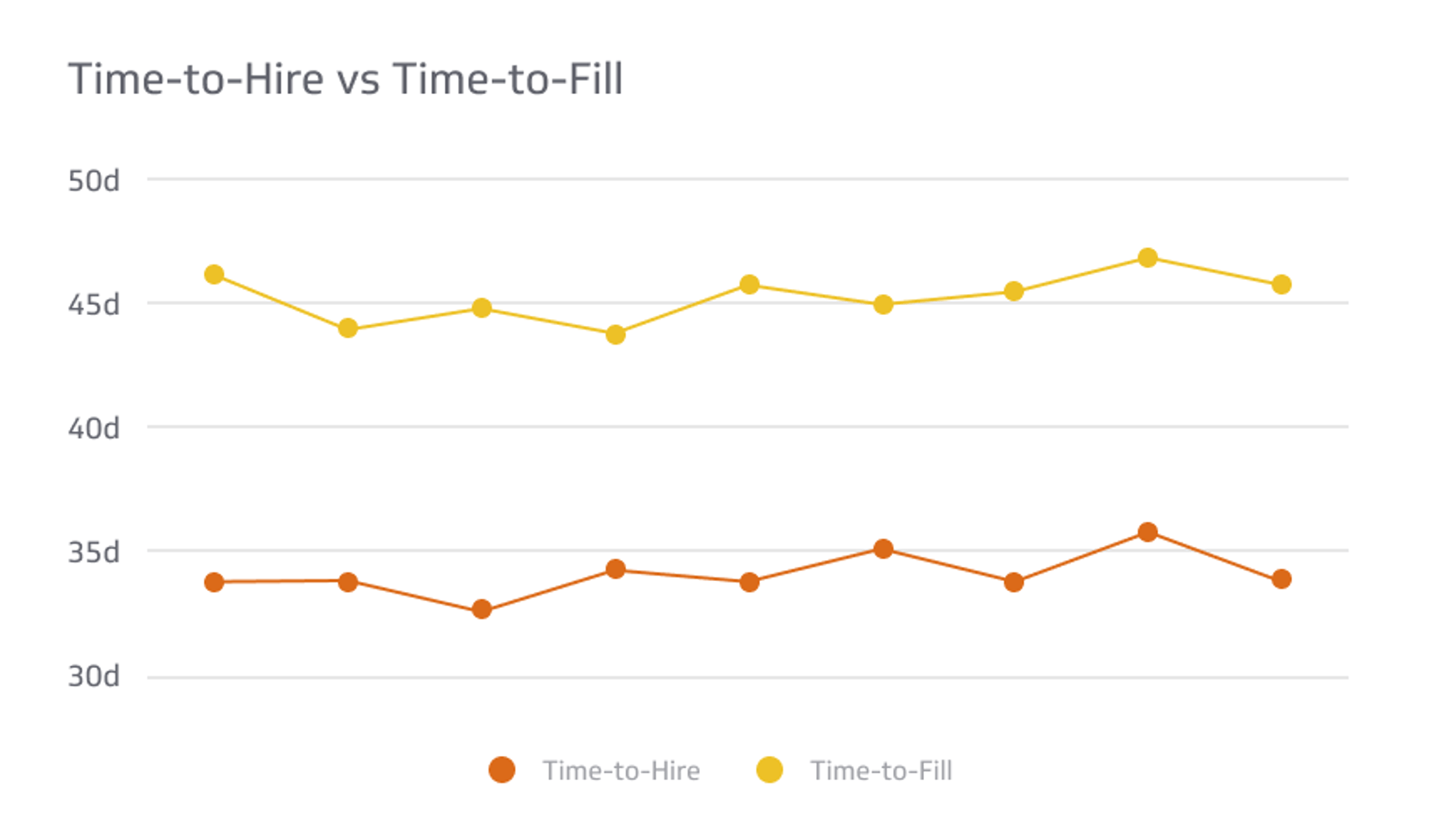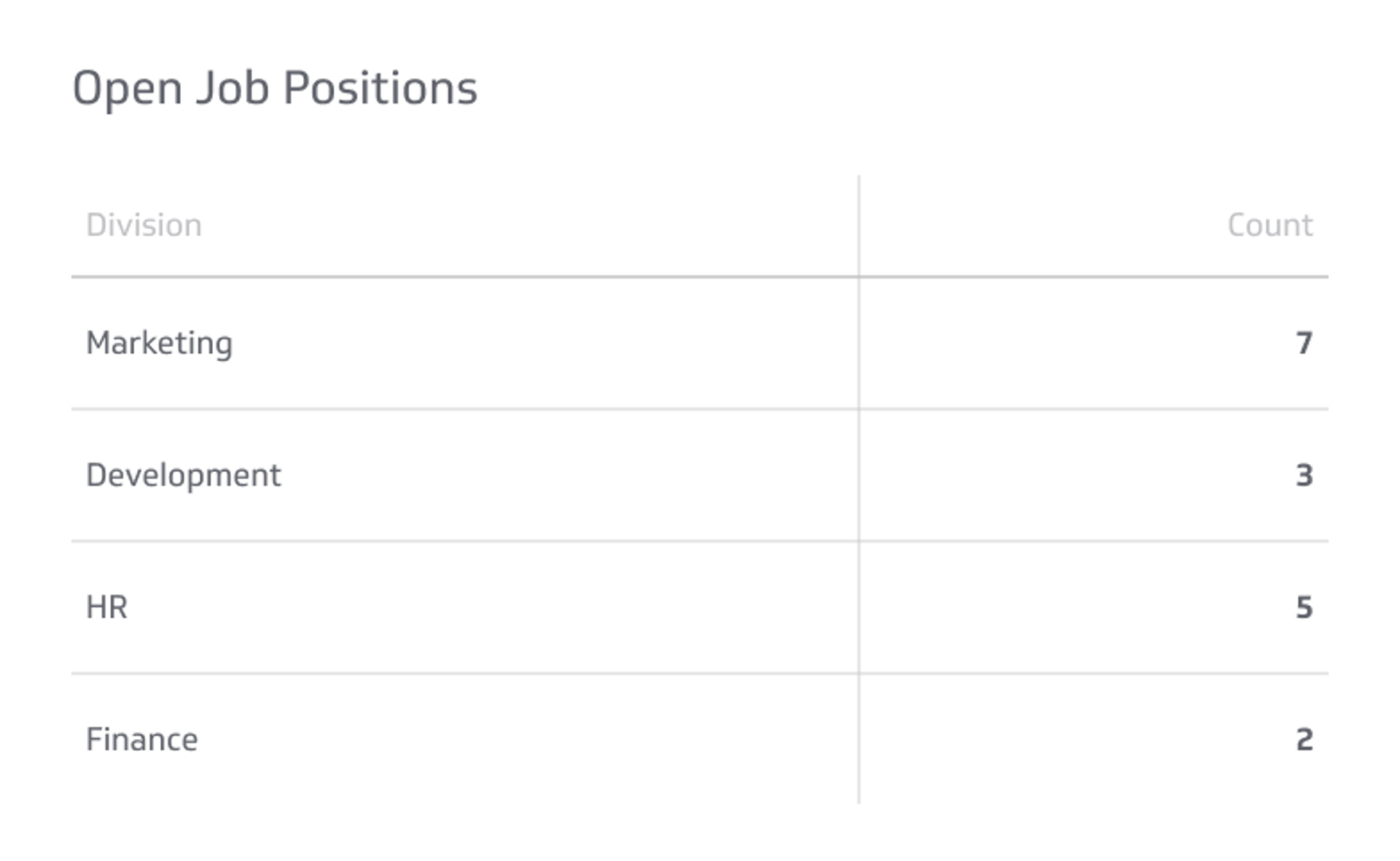Time-to-Hire vs Time-to-Fill
Time to hire focuses more on the candidate's experience of the hiring process, and time to fill focuses more on the company's policies and steps for seeking, choosing, interviewing, communicating, and hiring new candidates.
Track all your HR KPIs in one place
Sign up for free and start making decisions for your business with confidence.

Did you know that, on average, the hiring process takes 36 days to complete? Meanwhile, more than half of job seekers want an answer within two weeks of the interview date. Qualified candidates won't wait around for a callback, so companies with fast and efficient hiring practices will get their pick of the talent pool.
It's essential for HR teams and hiring managers to know the difference between time to fill vs. time to hire. These recruiting metrics provide valuable insight into your current hiring practices and can help reduce costs, save time, and improve the onboarding experience for new hires.
Moreover, companies that improve their time-to-fill and time-to-hire metrics are more likely to have the best pick of the most qualified candidates.
If you want to improve your hiring practices, continue reading to learn the difference between time to fill vs. time to hire, how to calculate your company metrics and more.
What Is Time To Hire?
Time to hire is a recruiting metric for the time it takes for an applicant to submit their resume until they accept the job offer. On average, the time to hire is ~24 days, but it can vary by industry.
Slow recruiting processes like interviewing too many prospective candidates or delays with the second round of interviews can increase the time to hire.
In some cases, the applicant can slow down this metric which, at first glance, is out of the company's hands. However, upon further inspection, maybe the hiring process needs some tweaks to ensure candidates are fully educated and informed.
Why Measure Time to Hire?
Recruiters must do all they can to keep hiring practices efficient so the time-to-hire metric stays as low as possible without sacrificing quality. Why? Because more than ¾ of applicants equate the hiring process with how a company values its employees.
Since most candidates want to hear back from a recruiter within two business weeks of their first interview, waiting longer than two weeks to reply sends applicants the message that you don't value their time.
By measuring your company's time-to-hire metric, HR teams gain valuable insight into what is slowing down the hiring process so companies make good impressions on all potential candidates.
By improving the time-to-hire metric, even those you don't offer a job to will be thankful for your prompt reply and likely be open to reapplying later. Likewise, quick responses better ensure that the talent you want is still available to accept your job offer.
Ways To Calculate Time To Hire
To calculate your company's time to hire, calculate the number of days between the date the applicant submitted their resume and the date they accepted the job. Then, add the numbers of days it took to hire each candidate and divide the total by the number of new hires.
For example, if Suzy submitted her job application on May 1st and accepted the job on May 21st, Suzy's time to hire is 21 days. Suppose another candidate's time to hire was 19 days. In that case, 21 + 19 = 40. 40 2 = 20, giving you the average time to hire as 20 days.
What Is Time To Fill?
Time to hire is often used interchangeably with time to fill, but these two terms are not synonymous. Time to fill is a lengthier process that starts on the date the new position gets approved and ends on the day the position is filled. The time to fill metric for most companies is upwards of 35 days.
Before a job posting gets listed, someone upstairs must decide what positions need filling. Once management gives the go-ahead to hire, the clock starts ticking on the time to fill metric.
While time to hire gives insight into how to improve efficiency in the hiring process, time to fill gives insight into recruiting practices by asking the following questions:
- How long does it take for departments to communicate?
- What tools get used to aid the recruiting process?
- How much time gets spent in each step of the process?
Why Measure Time to Fill?
Measuring the time it takes to fill a position is an important HR metric to track to determine how much time and money gets invested into every new hire. Once you investigate what slows the process down, the company can adjust practices to speed up the process and save money.
If a company's average time to fill is 39 days, when management gets a two-week notice, the company could experience losses with an empty desk for several weeks. Instead, knowing your company's time to fill allows recruiters to implement policies such as longer notice periods.
Plus, breaking down how long each hiring process step takes allows others to see the monetary consequences of delays.
Ways To Calculate Time To Fill
To calculate your company's time to fill, calculate the number of days between the date the job position was approved by management and the date the position was filled. Then, find the average time to fill by finding the sum of all candidates’ time to fill metrics and dividing them by the number of new hires.
For example, suppose management determined they needed a new employee and sent approval to HR to begin hiring on April 1st. Unfortunately, the HR manager overlooked the email, and the approval didn't get sent to the team until April 12th. The HR team posted the listing on April 20th. When Suzy accepted the job on May 21st, the time to fill was 50 days.
Time To Fill vs. Time To Hire
So, time to fill vs. time to hire, which recruitment metric is most important? Both are essential metrics worth tracking to improve hiring practices with efficiency and accuracy.
The main focus of both these metrics is to give insight into how delays or rushes in the hiring process can impact the quality of the candidate. For example, if you have a high-performing employee and know the data about how this employee got recruited, it can give insight into hiring practices worth doing.
Qualified candidates with glowing resumes and outstanding interview skills will likely use their valuable assets to seek other positions. However, if another company's time to hire and time to fill metrics are better than yours, even by a day or two, your team could lose out on a remarkable team member.
That said, it's important to know the timeline that works best for your company. Faster isn't always better. Rushed hiring practices can yield unfavorable results despite saving time, and tracking your time to hire and time to fill can give you the data to prove it.
How To Use Time To Fill and Time To Hire Metrics To Improve Hiring Practices
Breaking down the number of days each step in the hiring process takes is a goldmine for brainstorming hiring practices that focus more on efficiency without sacrificing quality and the necessary safeguards needed to onboard new staff.
Analyzing the numbers and comparing your metrics to competitors can reveal vital changes your company needs to make. Below are the top three ways you can use these recruiter metrics to improve your hiring practices.
1. Invest in Technology
HR teams are lucky to have lots of helpful technology on their side to help improve efficiency. Recruiter software comes in all shapes, sizes, and price points to suit different business needs.
If the HR team isn't utilizing technology to create optimized job postings, seek out talented candidates, or help narrow down applications, starting the interview process could take several weeks. By then, the good ones may have moved on.
Whether you need help sorting good resumes from bad, want to create quizzes to seek out the best candidates, or require help automating job posting to multiple job boards, investing in technology is one way to stay ahead of the competition and improve your time to hire and time to fill metrics.
2. Improve Communication
Analyzing recruitment metrics like time to fill vs. time to hire are key ways to find areas where communication needs improvement or policies that need to change to speed up the process.
Not only can companies use these metrics to improve interdepartmental communication to speed up the hiring process, but they also improve communication with candidates to improve the overall hiring experience.
For example, suppose you see a trend of candidates taking days to sign their acceptance because they're asking follow-up questions before joining the team. In that case, HR teams can use this data and improve the hiring process by sharing more information in the preliminary interviews and job post descriptions.
3. Simplify the Process
Tracking the data for your company's time to fill and time to hire can help recruiters to find areas where the hiring process can get simplified. Whether it's using technology to ease the workload or identifying unnecessary bottlenecks, these recruiting metrics are essential to finding and eliminating unnecessary steps that waste valuable time.
In Conclusion
It's essential to know the difference between time to fill vs time to hire to see the whole picture of the hiring process and improve it on both ends.
Companies that don't get introspective like this may find themselves behind the curve as competitors use technology to quickly weed out the top talent, create communication channels that benefit both the staff and those being interviewed, or innovate ways to make the hiring experience one that job seekers can walk away from feeling informed and valued.
Time to hire focuses more on the candidate's experience of the hiring process, and time to fill focuses more on the company's policies and steps for seeking, choosing, interviewing, communicating, and hiring new candidates.
Now that you understand the difference between time to fill vs time to hire, you're ready to start analyzing the data and discover ways to improve the hiring experience for the current staff and your new hires.
Related Metrics & KPIs



